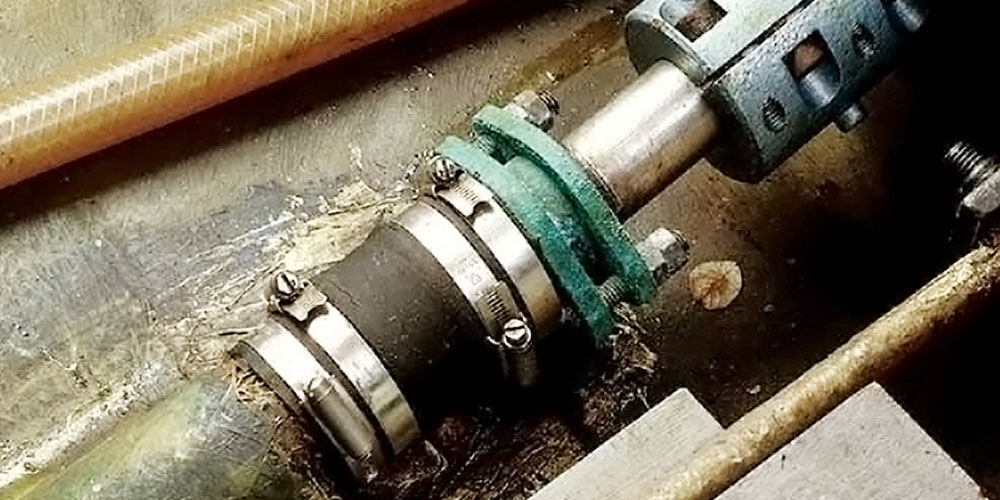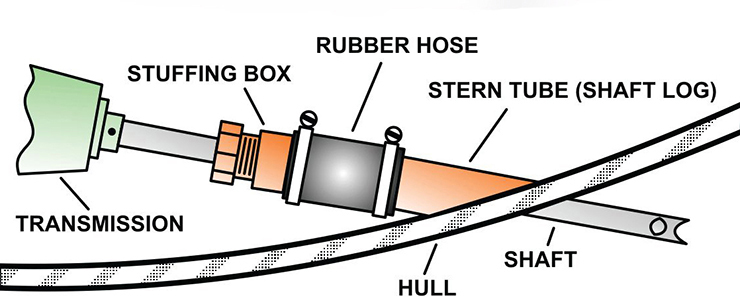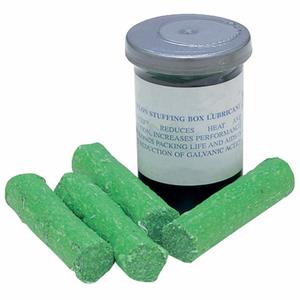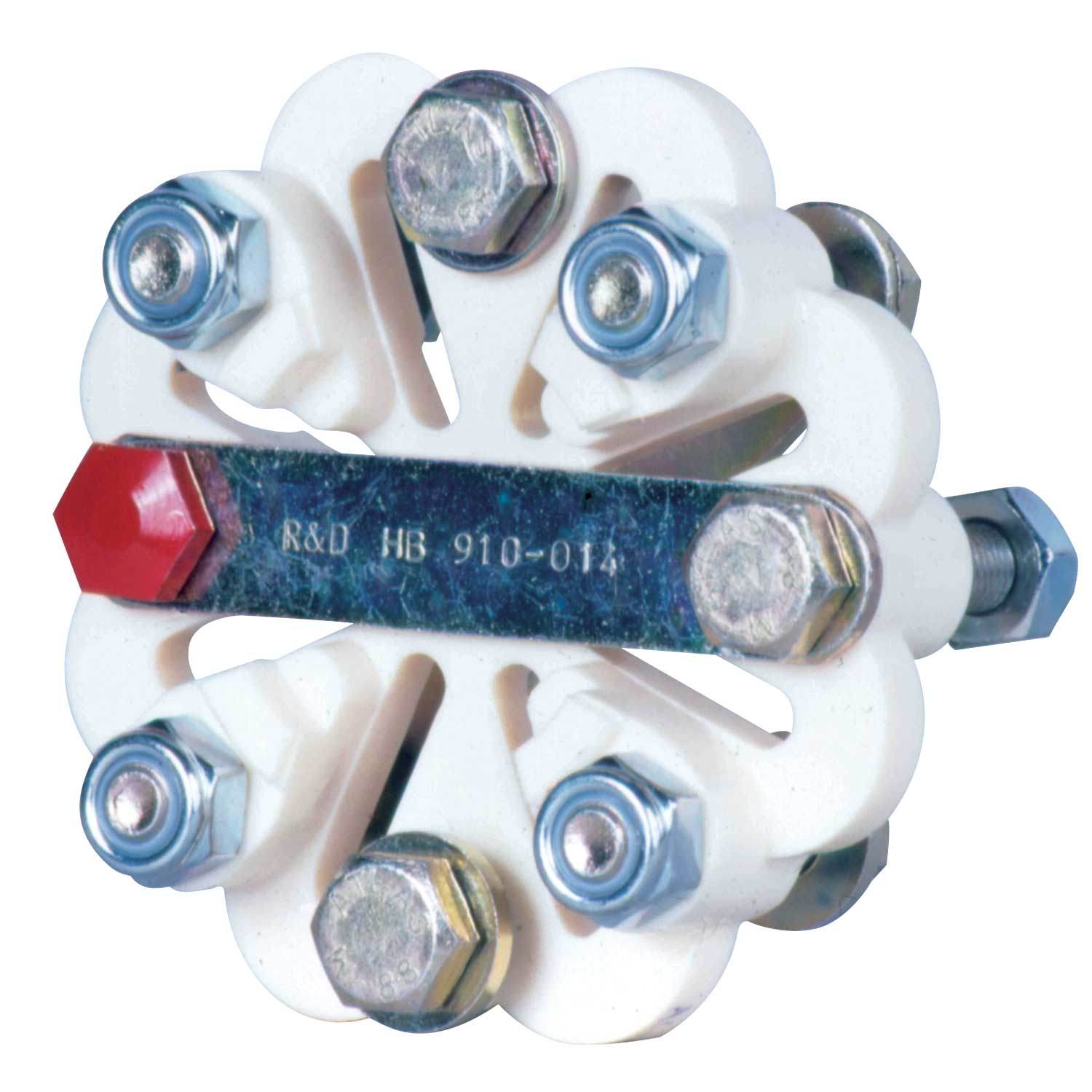
A marine stuffing box—also called a stuffing gland, packing gland or packing box—forms a seal between the prop shaft and the hole in the hull through which the shaft passes while allowing the shaft to turn freely. We'll walk you through how they work and how to replace packing and bearings when the time comes.
- How a Stuffing Box Works
- Flax Packing
- Determine What Size Packing You Need
- How to Install Flax Packing
- Shaft Seals
- How to Tell if Your Shaft Bearing is Bad
- How to Install a Shaft Bearing
- Stuffing Box and Shaft Bearing FAQs
How a Marine Stuffing Box Works

Illustration of traditional stuffing box. (Stuffing box lock nut not shown.)
A stuffing box—also consists of a threaded sleeve and a hollow nut, which the prop shaft passes through. The nut is filled with rings of wax-impregnated material, called flax packing, and screwed into the sleeve. The shaft packing is compressed around the smooth shaft as the nut is tightened and a little water is allowed to leak into the boat past the packing. The slight water leak serves to cool and lubricate the bearing, while the packing adjustment nut allows the flax to be tightened to adjust for wear. Over time, the seal breaks down and the flax packing must be replaced. Replacement flax is cut into small rings of material and inserted into the stuffing box.
Flax Packing
If your boat has a traditional stuffing box (described above) that is leaking excessively in spite of repeated tightening of the nut, you most likely need to replace the flax packing. West Marine offers three types of packing:

Drip-Less Moldable Marine Packing Kit
Regular flax: Properly installed flax consists of cut lengths of flax, bent into rings, which have their splits staggered around the shaft to minimize leakage. Properly packed flax is compressed and watertight, but decomposes into blackened fluff over time. Note: A properly adjust stuffing box will allow two or three drops of water per minute to enter the boat when the engine is running and the shaft is turning. This small amount of water serves to lubricate the shaft. Sealing the shaft completely will cause a buildup of heat and eventually damage the shaft.
Tallow, Paraffin or Teflon-impregnated flax: Impregnated flax packing is stronger and with Teflon added, creates even less friction against the turning shaft than standard wax impregnated flax.
Synthetic packing: An alternative to traditional rope-like flax packing can be found in the Drip-Less Moldable Packing Kit offered by West Marine. This is a clay-like substance designed to mold to the inside of the stuffing box to seal without water lubrication. Installation requires that the moldable packing material be sandwiched between two rings of conventional or impregnated flax. Although referred to as "dripless", some installations may require that a very small amount of water be allowed to drip into the boat to act as lubrication and reduce heat buildup.
Determine What Size Packing You Need
Flax packing comes in many different cross sections, depending on the distance between the shaft and the inside of the packing nut. Here are some guidelines:
| Shaft Size | Suggested Packing Size |
|---|---|
| 3/4" | 1/8" |
| 7/8" or 1" | 3/16" |
| 1 1/8" or 1 1/4" | 1/4" |
| 1 3/8" or 1 3/4" | 5/16" |
| 2" or 2 1/8" | 3/8" |
How to Install Flax Packing
Tools: To replace flax packing, you need two wrenches: one to release the lock nut that holds the packing adjustment nut in place and one to unscrew the packing nut itself. Use a corkscrew shaped packing extractor to dig out the old packing being sure to save some so it can be measured for replacement.
How much packing material is needed?

Traditional flax marine packing
In general, multiplying the shaft diameter by fourteen will yield the approximate number of inches of new flax packing necessary for four layers of new packing.
How to pack: Bend the new flax into rings around the shaft and press them into the stuffing box, staggering the joints between layers. Retighten the packing nut to compress the flax around the shaft and slow the water drip rate. Proper compression allows about two drops per minute. Run the engine in gear and then readjust the nut to achieve this rate.
Shaft Seals
The big advantage of shaft seals is that they eliminate the need for flax packing and the knuckle-busting experience (for some) of periodic tighening of a stuffing box nut. Shaft seals replace traditional stuffing boxes by using two polished surfaces, one stationary and one rotating, which form a seal around the prop shaft and don’t leak a drop. These seals have the advantage of being impervious to temperature, vibration and corrosion. They do not need any maintenance.
The Packless Sealing System
Packless Sealing System. Note the Flexible shaft coupling between the transmission output flange and the shaft coupling.
West Marine offers the Packless Sealing System (P.S.S.) shaft seal by P.Y.I. The system uses a high-density carbon/graphite flange that is attached to the boat's stern tube (also called a shaft log) by a nitrile bellows that uses water pressure to create a 100% watertight seal. The seal is not affected by temperatures, saltwater, corrosion, chemical or UV exposure. These seals are offered in a variety of sizes and the controlling dimensions are the shaft diameter and the diameter of the stern tube. Sizes are available for all engine systems, regardless of rpm.
Important tip for dripless shaft seals!
Drip-proof shaft seals such as the P.S.S. seals described above must be “burped” before the boat is operated after a haul-out. This is done by pulling the rubber bellows slightly to let water push the air inside the seal out. If this is not done, the shaft seal will get hot quickly (without water contact) and destroy itself.

R&D Marine's Flexible Shaft Engine Coupling
Flexible Couplings by R&D Marine
If you are planning to install a P.S.S. sealing system, consider also installing a flexible coupling by R & D Marine. This flexible coupling installs between the transmission output flange and the shaft flange to absorb shock loads resulting from gear changes or from the propeller striking a submerged object. It’s made with a polyester elastomer and the metal compression strap that keeps the coupling intact if the disc is destroyed, ensuring that the drive system still functions. R & D Marine flexible couplings come with the required installation hardware and are available for engines from 5 to 1,500hp.
How to Tell if Your Shaft Bearing is Bad
If you experience excessive vibration or hear the sound of a dinner bell when you put your boat in gear, you might need a new shaft bearing. As mentioned, traditional shaft bearings are rubber-lined brass sleeves that mount within the support strut or stern tube that supports the propeller shaft. In addition to traditional rubber/brass bearings, Trellex-Morse also offers shaft bearings with a non-metallic sleeve. Shaft bearings are designed to slide tightly into the stern tube housing or strut and the prop shaft passes through the center of the bearing. The nitrile rubber lining of the bearing prevents vibration, permits the shaft to turn freely and allows water to lubricate and cleanse the shaft as it turns.

Trellex-Morse Shaft Bearing
Shaft bearings come in many sizes because of the tight tolerances necessary to achieve a proper fit. They are specified by shaft diameter, outside diameter and length. West Marine stocks a large selection from Trellex-Morse. The bearings use fish names that indicate inner tube diameters: Albacore, Barracuda, Cod, etc. The first letter of the name denotes the I.D. of the bearing (A=3/4”, B=1”, C=1 1/4”, etc.) Other important dimensions are the outer tube diameter and length.
How to Install a Shaft Bearing
Shaft bearings are actually much easier to install then they are to remove. When attempting bearing maintenance, the prop shaft must first be removed to prevent any damage to it. The bearing can be installed by gently tapping it into the strut with a rubber mallet. It is usually held in place by a setscrew or flange. Once the bearing fails (as it will eventually) it is virtually impossible to extract them from the strut or stern tube unless the boat has been hauled. If light tapping with a dowel or pin punch doesn’t work, try using a hacksaw or Sawzall to remove it, taking care not to saw into the stern tube or strut. Although the old bearing is destroyed this way, it doesn’t really matter because it’s useless once it’s worn out.
Available Shaft Bearings
Below are links to four types of Trellex-Morse shaft bearings. As mentioned, West Marine carries many, but not all of the bearings that Trellex-Morse makes. If your boat requires a bearing that West Marine does not stock, please contact our customer service center to place a special order.
Stuffing Box and Shaft Bearing FAQs
What is a stuffing box, and why is it important? A stuffing box, also called a packing gland, is a component that seals the gap between the propeller shaft and the boat’s hull, allowing the shaft to rotate while preventing excessive water from entering. It’s essential for keeping your boat watertight and protecting the prop shaft.
How does a traditional stuffing box work? A traditional stuffing box uses a threaded sleeve and hollow nut filled with wax impregnated flax packing material. As the nut is tightened, it compresses the flax around the prop shaft, creating a nearly water-tight seal while allowing a controlled drip of water to lubricate the shaft and prevent overheating.
When should I replace the flax packing in my stuffing box? Flax packing should be replaced when tightening the packing nut no longer controls the leak or if excessive water is dripping through. Over time, flax packing decomposes and becomes less effective, so routine inspection and replacement are advised.
What type of flax packing should I use? The type of packing depends on your preferences and usage. Options include standard waxed flax, Teflon-impregnated flax for reduced friction, and synthetic moldable packing.
How do I know what size flax packing to use? Packing size depends on the distance between the shaft and the packing nut. For example, a 3/4" shaft typically requires 1/8" packing, while larger shafts require thicker packing. Consult sizing charts to find the right fit.
What’s the difference between a stuffing box and a shaft seal? A shaft seal, like the Packless Sealing System, provides a dripless, maintenance-free alternative to traditional stuffing boxes. Instead of flax packing, shaft seals use polished surfaces to form a watertight seal around the shaft, eliminating the need for regular adjustment and reducing wear.
How can I tell if my shaft bearing needs to be replaced? Signs of a worn shaft bearing (also called a "cutlass bearing") include excessive vibration or a metallic sound when the shaft is in motion. Bearings should be checked regularly, as they support the shaft, reduce vibration, and keep it aligned.
